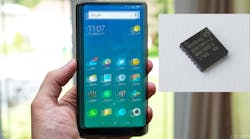Tired: haptics technology that enables smartphones to vibrate with new message alerts. Wired: more advanced haptics that recreate the sensation of pressing a physical key on a touchscreen. Inspired: high-definition haptics that imitate the texture of a sweater’s fabric so that people shopping on their devices can feel before they buy.
We are still a long way from that seeing that technology. But to recreate that very specific sensation will require tiny devices called piezoelectric actuators that can generate a precise amount of haptic feedback. These parts are unable to function without large amounts of power, which has kept them out of things like smartphones and wearables. But a new startup, Boreas Technologies, could help change that.
On Tuesday, the company introduced a high-voltage, low-power driver IC designed from the ground up for these actuators. “The electronics required to operate these actuators has not been very efficient, preventing companies from using piezoelectric actuators in consumer products,” said Simon Chaput, chief executive and founder. Changing that could move more responsive and realistic haptics into applications with power and thermal constraints.
That could include not only smartphones and wearables but also home appliances and cars.
With the new BOS1901, Boreas is trying to pry into the haptic driver market, which will grow to an estimated $13.7 billion by 2022, according to BCC Research. Texas Instruments has long dominated the piezoelectric driver market. Boreas may have a chance to outpace its Dallas, Texas-based rival in high-definition haptic driver ICs. The market is forecast to grow from roughly $1.5 billion to $5.6 billion over the next half decade.
Piezoelectric actuators are growing in importance versus linear resonant actuators (LRAs) and eccentric rotating mass (ERM) motors, which are what provide basic vibrations in smartphones and gaming controllers. In addition to occupying more space than piezoelectric actuators, these technologies generally draw more power have slower response times. That limits their usefulness for future high-definition haptics, Chaput said.
Boreas, which was founded in 2016 and currently employs 12 people, built its CapDrive chip technology to take advantage of the wider bandwidth and lower power of piezoelectric actuators. Its first product consumes around 10 times less energy than rival hardware, the startup said. It also leverages the responsiveness of these actuators with 300-microsecond latency, six times faster than anything else out there, the startup said.
James Hayward, an analyst with market researcher IDTechEx, said that “piezoelectric actuators typically require driving at high voltage, meaning issues with efficiency or distortion can lead to poor power consumption, noise and other challenges.” Higher driving voltages—typically around 100 volts, according to Chaput—have made it harder to install the technology in small battery-operated devices, said Hayward.
Boreas said that it would offer the new product at the same or a lower price than rival devices. Chaput said that, unlike Texas Instruments, which adds discrete solutions to support high voltages, its new haptic driver only needs supply voltages between 3 and 5.5 volts. It requires no additional power-supply hardware. And the chip only needs seven external component to function, potentially saving customers board space.
Boreas takes advantage of piezoelectric actuators in other ways. In contrast to current actuators, they can be used to not only recreate the sensation of touch but also sense whether someone has touched a screen. The BOS1901 has differential output so that it can support both functions. Without that capability, many more drivers could be needed to enable localized haptics—which allows virtual buttons anywhere on a screen to give users feedback.
The company is also aiming to lower the bar for replacing physical buttons with virtual ones, a technology currently limited to device manufacturers that can build it themselves. In 2016, Apple replaced the home button in the iPhone with its custom Taptic Engine. Installed under the glass, the part helps recreate a physical key press. It measures the force of a person’s finger and uses haptic feedback to tell the user that their touch registered.
“The value of haptics is not something people are aware of before they feel it, so when you get used to devices that have haptics I think it would be difficult to go back to something without it,” Chaput told Electronic Design last week. “Within the next couple of years, if you interact with some device that doesn’t have haptics, I think you will probably start wondering whether it’s broken.”
The technology behind CapDrive was developed inside Harvard University as part of a project to build a higher efficiency driver for piezoelectric fans. Chaput led the development of the chip, which targeted applications like tablet and laptop cooling. The Quebec, Canada-based company has since shifted its focus to haptic technology. The company raised its first round of venture capital last year but has declined to comment on the total.
Other companies are also targeting piezoelectric haptics. Amsterdam, Netherlands-based Aito offers a combined touch controller and haptics driver that uses no power in standby mode. The device is designed to control tiny piezoelectric discs, the same ones used in greeting cards to activate songs. The company has demonstrated its chips in home appliances from LG Electronics and partnered with Flextronics on in-vehicle systems.
Boreas announced that its new product is available in a development kit. The board uses piezoelectric actuators from both TDK and Midé Technology, which has been pushing the BOS1901 to customers after previously recommending drivers from Texas Instruments. Boreas expects to enter volume production in the first quarter next year. Chaput said that the company plans to raise new funding to accelerate its growth in 2019.
But for now the company's "supply chain is already set up to handle the very high volumes generally seen in the mobile market space,” he said.

